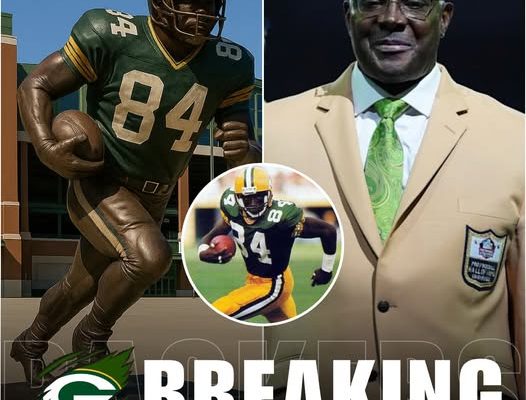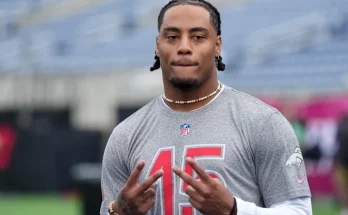Sterling Sharpe’s journey from a South Carolina standout to an NFL icon has long been a tale of what could’ve been and what undeniably was. For years, fans of the Green Bay Packers have wondered why his name didn’t reverberate through the halls of Canton, Ohio. He was one of the most feared wide receivers of the 1990s, a five-time Pro Bowler, a three-time All-Pro, and a man whose career, though cut short by injury, burned with the brilliance of a thousand spotlights. Now, after a deeply emotional induction into the Pro Football Hall of Fame and decades of waiting for the recognition he always deserved, Sharpe is receiving the ultimate honor from the team that watched him dominate the gridiron—the Green Bay Packers have announced a \$4.9 million bronze statue of Sharpe will be erected at Lambeau Field. This moment is more than just a tribute; it’s a resurrection of a legacy that had long simmered just beneath the surface of NFL immortality.
Sharpe’s statue won’t just be another artistic rendering of a player in motion—it will be a towering symbol of greatness, perseverance, and the unique brand of excellence that defined Packers football in the early ‘90s. The plans, unveiled by Packers President Mark Murphy, include a 12-foot bronze likeness of Sharpe in mid-stride, palms up, eyes focused, recreating the fierce determination that made him nearly uncoverable during his prime. The statue will be placed adjacent to those of Bart Starr, Vince Lombardi, and Curly Lambeau—a placement that says more than words ever could about Sharpe’s place in Packers lore.
What makes this announcement even more powerful is its timing. Just weeks after his long-awaited enshrinement into the Pro Football Hall of Fame, where his younger brother Shannon Sharpe gave a tearful and passionate introduction, the Packers’ decision to immortalize Sterling at Lambeau represents a full-circle moment. For years, Sharpe’s career was overlooked because of its brevity. But as Hall of Fame voters and the Packers organization alike have now acknowledged, greatness isn’t measured by longevity alone. In his seven seasons, Sterling Sharpe did more than most players accomplish in fifteen. He was a catalyst. A force of nature. A nightmare for defenders and a lifeline for quarterbacks.
When Sharpe entered the league in 1988 as the seventh overall pick, he didn’t just meet expectations—he obliterated them. His rookie season saw him put up 55 receptions, and by his second year, he had already crossed the 1,000-yard mark. But it was 1992 and 1993 that would truly cement his place in football history. In 1992, he led the NFL in receptions, receiving yards, and touchdowns—a rare Triple Crown feat—and followed that up with 112 catches and another league-leading touchdown tally in 1993. His chemistry with then-rookie quarterback Brett Favre was instantaneous and electric. Favre himself has often credited Sharpe with accelerating his development, stating that having a receiver like Sterling gave him the confidence to take risks and push boundaries early in his career.
But it wasn’t just the numbers that defined Sharpe—it was the way he played. He had hands like industrial clamps, precise route running, deceptive speed, and a level of aggression after the catch that made defensive backs think twice. He played every down like it might be his last, and sadly, that mindset proved eerily prophetic. In 1994, at the peak of his powers, Sharpe suffered a neck injury that would end his career at just 29 years old. It was a heartbreaking end to a meteoric rise. For fans, coaches, and especially his teammates, it was like watching a comet vanish mid-flight.
Yet even in retirement, Sharpe’s influence never waned. His voice as an analyst on television remained as sharp as his play on the field. He became a respected figure off the field, known for his intense football IQ, his unapologetic honesty, and his unwillingness to sugarcoat mediocrity. And though he rarely lobbied for Hall of Fame induction, those close to him never stopped fighting for his legacy. Shannon Sharpe, already in the Hall of Fame himself, often made it clear that his brother was the better athlete and the one who should have gotten there first. His speech at Sterling’s enshrinement ceremony this year was a raw, emotional acknowledgment of that truth—and a public exhale for a family that had waited decades for vindication.
The decision by the Packers to commission a \$4.9 million statue sends a strong and clear message: that Sterling Sharpe is not just a footnote in Green Bay history, but a foundational pillar. The money, funded through a combination of team contributions and private donor support, is being funneled into a work of public art that will reflect the sweat, grit, and unyielding spirit of one of football’s greatest receivers. Designed by renowned sculptor Julie Rotblatt-Amrany, known for her work on the Michael Jordan statue outside the United Center, the piece will reflect not just Sharpe’s physical dominance but also the emotion and passion he brought to the game.
For Packers fans, the unveiling will be more than just a ceremonial affair. It will be a moment to educate younger generations on the greatness that came before Favre-to-Driver, before Rodgers-to-Adams. Sterling Sharpe was the prototype. He was the reason defenders feared Green Bay even when the franchise was in transition. He played on teams that didn’t always win, but he made sure they always mattered. And now, decades later, those contributions will stand frozen in time, forever part of Lambeau’s hallowed grounds.
The statue will be unveiled during the 2026 NFL season, coinciding with the Packers’ 100th anniversary celebration of Lambeau Field. The team has already begun planning a weekend-long series of events, including a Sharpe family reunion tailgate, a ceremonial coin toss with Sharpe himself, and a tribute video featuring testimonials from Brett Favre, Mike Holmgren, Jerry Rice, Michael Irvin, and Shannon Sharpe. The event is expected to draw tens of thousands, not just because of the player being honored but because of what his story represents—talent, cut short too soon, but never forgotten.
In an era where sports often feels fleeting and consumed by headlines, viral highlights, and hot takes, the Packers are reminding the world that true legacy is eternal. Sterling Sharpe didn’t need 15 seasons to become a legend. He didn’t need a Super Bowl ring to leave his mark. What he had was impact—the kind that makes a franchise stand taller, that makes a brother shed tears of pride, that makes fans remember where they were when greatness was on display.
Sharpe’s name will now be forever etched alongside Packers royalty—not just in record books, but in bronze. And for a man who gave everything to the game, even when the game gave him too little time, there could be no better tribute. The Valley of Green and Gold has found its next eternal flame, and his name is Sterling.



